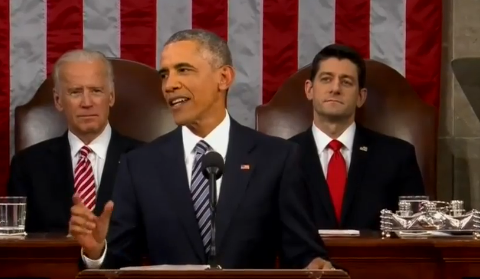President Commits to Continuing Climate Leadership

After Paris success in 2015, HFC amendment expected in 2016, avoiding 0.5°C of warming
12 January 2016 – President Obama re-committed tonight in his final State of the Union address to continue his efforts to reduce the threat of climate change, making it a key part of his vision of how to keep American great in the long term. This includes having the United States develop the clean energy needed to replace climate-damaging fossil fuels, according to the President.
“In addition to developing clean energy, the President also has been a champion of cutting short-lived super climate pollutants, starting with HFC refrigerants, but also including black carbon soot, methane, and tropospheric ozone, the main component of urban smog,” said Durwood Zaelke, President of the Institute for Governance & Sustainable Development. “And we expect him to re-double his efforts on this front this year as well.”
The President has been a champion of using the Montreal Protocol to phase down HFCs, which will provide the opportunity for the US industry to produce new alternatives to HFCs, including the so-called “natural refrigerants” as well as new formulations of fluorinated gases.
An HFC phase down would provide climate mitigation equal to up to 100 billion tons of carbon dioxide by 2050 and avoid up to 0.5°C of warming by 2100, a major contribution to the world’s efforts to keep temperatures from passing 1.5°C or at most 2°C above pre-Industrial levels.
In November 2015, the Parties to the Montreal Protocol agreed to work together in 2016 to an agreement to phase down HFCs, which are potent factory-made gases primarily used in refrigeration and air-conditioning. This year it is anticipated that Mr. Obama and his team will accelerate their efforts to phase down HFCs under the Montreal Protocol, which would eliminate the warming from one of the six main greenhouse gases.
The administration is also closing in on actions to reduce other short-lived super pollutants like methane, black carbon soot, and tropospheric ozone. This includes a string of new methane rules anticipated to be finalized shortly. Last August the Obama administration announced federal regulations to reduce 2025 methane emissions from oil and gas production by 40 to 45% from 2012 levels.
Reducing the short-lived super pollutants has the potential to cut the rate of global warming by half and Arctic warming by two-thirds. As Chair of the Arctic Council this year, Secretary Kerry has the opportunity to accelerate reduction of black carbon. Further action on super pollutants can be had from expanded coordination with the Climate and Clean Air Coalition to Reduce Short-Lived Climate Pollutants, a UNEP action group launched by Hilary Clinton during her time as Secretary of State.
IGSD’s Primer on HFCs is here & Primer SLCPs is here.
